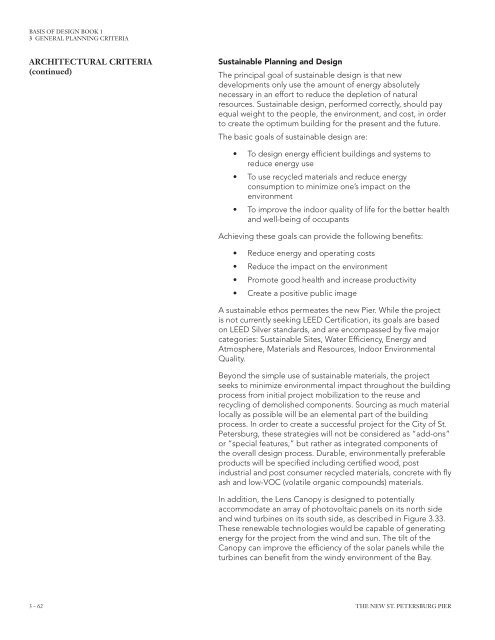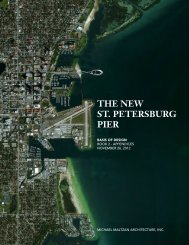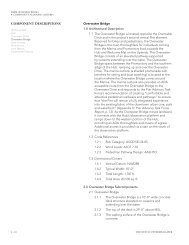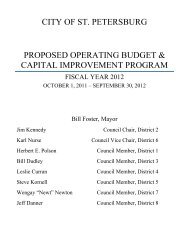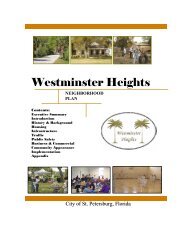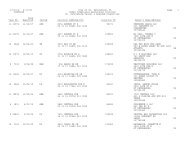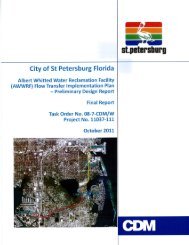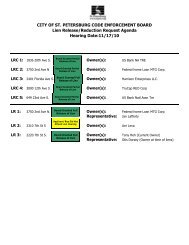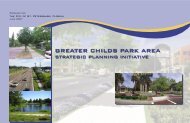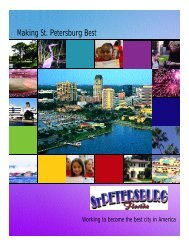Book 1 - City of St. Petersburg
Book 1 - City of St. Petersburg
Book 1 - City of St. Petersburg
You also want an ePaper? Increase the reach of your titles
YUMPU automatically turns print PDFs into web optimized ePapers that Google loves.
BASIS OF DESIGN BOOK 1<br />
3 GENERAL PLANNING CRITERIA<br />
ARCHITECTURAL CRITERIA<br />
(continued)<br />
Sustainable Planning and Design<br />
The principal goal <strong>of</strong> sustainable design is that new<br />
developments only use the amount <strong>of</strong> energy absolutely<br />
necessary in an effort to reduce the depletion <strong>of</strong> natural<br />
resources. Sustainable design, performed correctly, should pay<br />
equal weight to the people, the environment, and cost, in order<br />
to create the optimum building for the present and the future.<br />
The basic goals <strong>of</strong> sustainable design are:<br />
• To design energy efficient buildings and systems to<br />
reduce energy use<br />
• To use recycled materials and reduce energy<br />
consumption to minimize one’s impact on the<br />
environment<br />
• To improve the indoor quality <strong>of</strong> life for the better health<br />
and well-being <strong>of</strong> occupants<br />
Achieving these goals can provide the following benefits:<br />
• Reduce energy and operating costs<br />
• Reduce the impact on the environment<br />
• Promote good health and increase productivity<br />
• Create a positive public image<br />
A sustainable ethos permeates the new Pier. While the project<br />
is not currently seeking LEED Certification, its goals are based<br />
on LEED Silver standards, and are encompassed by five major<br />
categories: Sustainable Sites, Water Efficiency, Energy and<br />
Atmosphere, Materials and Resources, Indoor Environmental<br />
Quality.<br />
Beyond the simple use <strong>of</strong> sustainable materials, the project<br />
seeks to minimize environmental impact throughout the building<br />
process from initial project mobilization to the reuse and<br />
recycling <strong>of</strong> demolished components. Sourcing as much material<br />
locally as possible will be an elemental part <strong>of</strong> the building<br />
process. In order to create a successful project for the <strong>City</strong> <strong>of</strong> <strong>St</strong>.<br />
<strong>Petersburg</strong>, these strategies will not be considered as “add-ons”<br />
or “special features,” but rather as integrated components <strong>of</strong><br />
the overall design process. Durable, environmentally preferable<br />
products will be specified including certified wood, post<br />
industrial and post consumer recycled materials, concrete with fly<br />
ash and low-VOC (volatile organic compounds) materials.<br />
In addition, the Lens Canopy is designed to potentially<br />
accommodate an array <strong>of</strong> photovoltaic panels on its north side<br />
and wind turbines on its south side, as described in Figure 3.33.<br />
These renewable technologies would be capable <strong>of</strong> generating<br />
energy for the project from the wind and sun. The tilt <strong>of</strong> the<br />
Canopy can improve the efficiency <strong>of</strong> the solar panels while the<br />
turbines can benefit from the windy environment <strong>of</strong> the Bay.<br />
3 - 62<br />
THE NEW ST. PETERSBURG PIER


